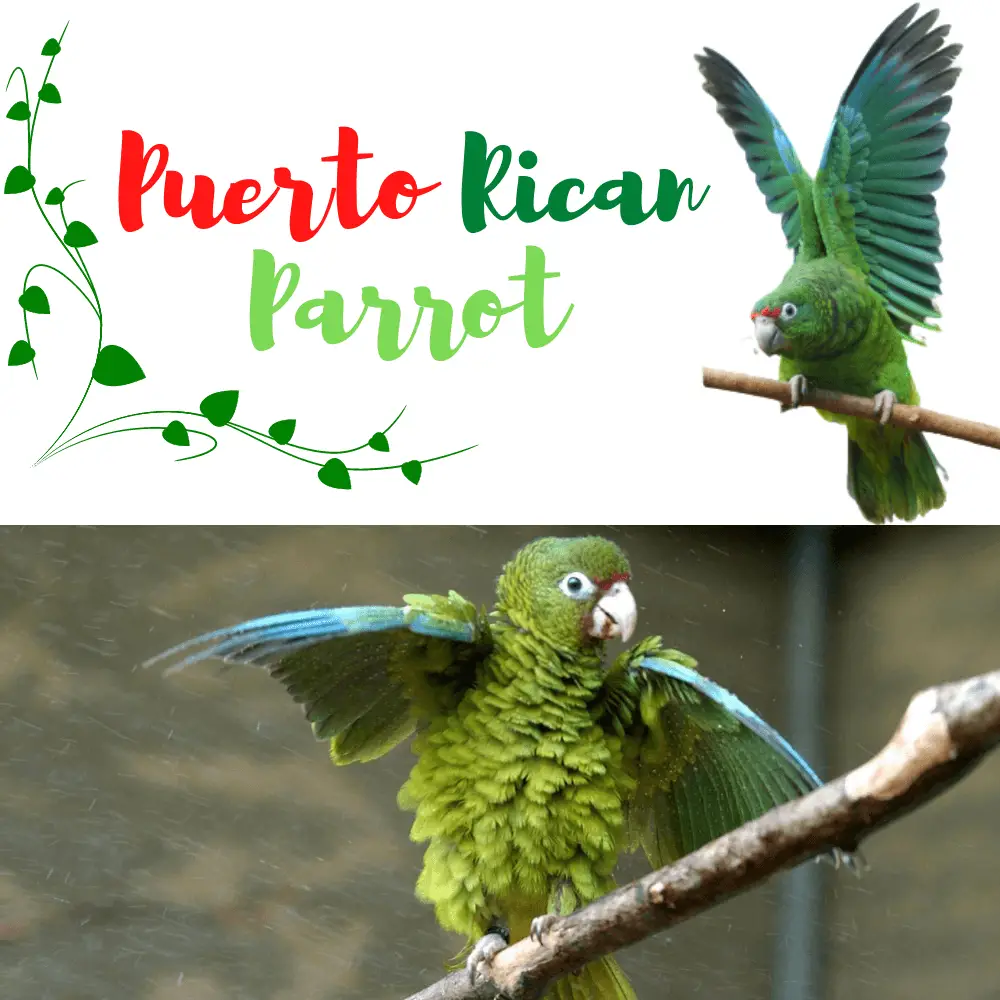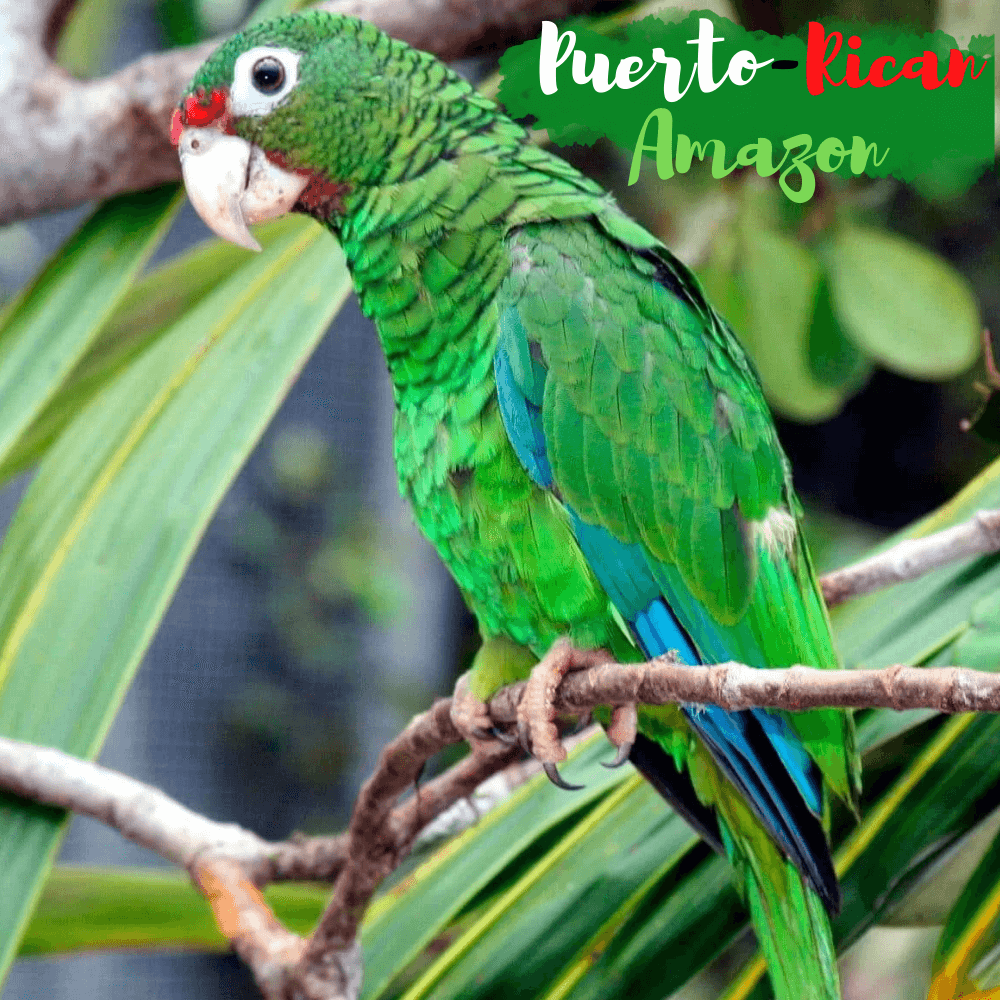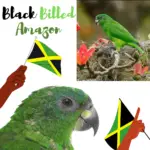
The Puerto Rican Amazon (Amazona vittata)or Puerto Rican parrot is an Amazon Parrot species of bird endemic to the Puerto Rican archipelago belonging to the neotropical genus Amazona.
Measuring 28 to 30 cm, the Puerto Rican Amazon is a green parrot with a red forehead and white eye circumference. Two subspecies have been described, although there remains some doubt about the distinctive characteristics of the gracilipes subspecies of the island of Culebra, extinct since 1912. Its closest relatives may be the Cuban Amazon (Amazona leucocephala) and the Hispaniola Amazon (Amazona ventralis).
The Puerto Rican Amazon reaches sexual maturity at the age of three or four. It breeds once a year and nests in cavities. As soon as the female has laid her eggs, she stays in the nest and incubates them until they hatch. Nestlings are fed by both parents and take their first flight 60-65 days after hatching. The diet of this amazon is varied and includes flowers, fruits, leaves, bark, and nectar harvested from the canopy.
This species is the last species of parrot native to the island of Puerto Rico. It has been classified as a Critically Endangered Species by the International Union for Conservation of Nature since 1994. Formerly, this bird was distributed over an important area and present in abundance, but its population declined sharply in the nineteenth century and the early twentieth century with the disappearance of a very large part of its habitat. This species has completely disappeared from the island of Vieques and Isla Mona and is threatened with extinction on the main island of Puerto Rico. Efforts for its preservation were set up in 1968 in an attempt to allow this bird to escape extinction. In 2006, the total population is estimated at between 34 and 40 individuals in the wild and 143 in captivity.
Puerto Rican parrot
SOURCE:BRUCE THORSON
Morphological description
Puerto Rican Amazon in flight, seen from behind, showing its distinctive bright blue feathers.
The Puerto Rican Amazon is between 28 and 30 cm in length and weighs on average 250 to 300 g. It is rather small compared to Amazons in general, but its size is similar to that of Greater Antilles Amazons in particular. This species does not exhibit sexual dimorphism. Both males and females have predominantly green plumage on the top of the body, although some feathers have a blue border. The primary remiges and some tectrices are dark blues. The color of the feathers below the body is variable: the underside of the wings, which is seen when the bird is in flight, is bright blue, and the underside of the tail is greenish-yellow. Their irises are brown, their beak pale yellow and their legs brownish-yellow. Except by DNA testing, males and females can only be distinguished by their differences in behavior during the breeding season. Juveniles have the same plumage as adults.
Behavior
The Puerto Rican Amazon is diurnal and usually starts its activity half an hour after sunrise. It is inconspicuous when it is at the nest, using its green plumage to camouflage itself; on the other hand, it is often noisy outside the nest. When it takes flight, the blue color of its plumage contrasts with the green of the forest. The flight of this species is similar to that observed in other Amazons, with wing movements below the axis of the body, unlike many birds whose wings pass over the body during flight. These Amazons can fly quite fast, reaching a top speed of about 30 km/h, and are agile enough to escape their predators in the sky. When looking for food, these parrots group in pairs, but pairs and their chicks tend to stay together. These Amazons have two call calls in flight, a start-up cry consisting of a series of long hoarse cries, and a loud “bugle” that can have different meanings depending on the circumstances.
Power supply
Like most Amazons, the Puerto Rican Amazon is herbivorous. Its diet consists of flowers, fruits, leaves, bark, and nectar from the canopy. 60 different foods are known to be consumed regularly by the species, although its diet has likely been more varied in the past when its habitat was larger. It consumes in particular the pericarp of the seeds of rosary palm kernel (Prestoea acuminata montana), gum (Dacryodes excelsa) and Matayba domingensis, fruits of Marcgravia sintenisii, Miconia sintenisii, Gundlach Clusier, and Rheedia portoricensis, flowers of Marcgravia sintenisii, toad wood ( Alchornea latifolia) and Piptocarpha tetrantha, the leaves and twigs of Grisebach’s Clusier, laurel-magnolier (Magnolia splendens), Micropholis garciniaefolia and Piptocarpha tetrantha, the bark of Marcgravia sintenisii, Clusia grisebachiana and brown coffee (Psychotria berteriana) and sweet pea buds (Ingaga Vera). She chooses the fruits directly in front of her, catching them one by one. During her meals, she uses a paw to grab her food. The Puerto Rican Amazon feeds slowly, taking between 8 and 60 seconds to consume food.

Reproduction
A couple of Amazons from Puerto Rico.
Puerto Rico’s Amazon is monogamous; it usually forms a pair for life and a change of partner occurs only if one of the birds of the couple dies or leaves the nest. However, it can happen that the male leaves the female if she is injured, to find one in better health. It is not really known how the pairs are formed, however, the new partners participate in courtship displays with simultaneous reverences of the male and female, a partial extension of the wings, and deployment of the fantail.
The Puerto Rican Amazon nests in cavities, including hollow tree trunks. These cavities can be of natural origin or created by other species. This species preferentially opts for trunks of Cyrilla racemiflora, but also uses other trees such as laurel-magnolia (Magnolia splendens) and gum tree (Dacryodes excelsa), with less frequency. These trees tend as they age to dig cavities, thus providing shelter from predators and bad weather. Recently, the species has also nested in artificial wooden boxes as part of the species’ conservation plan. The nests are located at a height varying between 7 and 15 meters from the ground. The male usually takes care of the search for a nesting site, but the final decision seems to be made by the female. Once the place is chosen, the couple will inspect and clean it thoroughly, but no material will be added to garnish the nest.
Chick.
The Puerto Rican Amazon reaches sexual maturity at the age of 4 years in the wild and 3 years in captivity. The species usually breed once a year between January and July (i.e. during the dry season). Mating seems to be linked to food exchanges, which could also trigger copulation. Amazons have a mating pattern similar to that of other American Psittacidae, with the male grabbing a branch with one leg, and placing the second on the back of the female. When the time of laying eggs approaches, the pair spends more time in the nest, the male feeding the female by regurgitation. The female lays 2 to 4 white eggs that she incubates alone for a period of 24 to 28 days, the male being present near the nest only when he brings food. Females rarely leave the nest, and only to repel a possible predator or if the male does not bring food for too long. Nestlings are fed by both parents until they leave the nest, about 60-65 days after hatching. Nevertheless, they remain dependent on their parents and follow them until the next breeding season.
Like other Amazons, the Puerto Rican Amazon is gregarious in its daily activities, but territorial near its nest. The territory extends for about 50 m around the nest. Pairs are extremely cautious near their nest, moving slowly when they leave it to avoid attracting the attention of predators. Although the defense of the territory is mainly done with the help of loud calls, it can happen that the parrot fights to protect its nest. Pairs defend their nests against other intruder pairs and sometimes focus more on defending the nest than on laying eggs. Pairs that nest in an area with no other parrots remain silent unless an intruder occurs. Some pairs have some territory defense behaviors even when they do not intend to nest, mainly in the second part of the breeding season. They could be young couples who have not quite reached maturity, and this behavior could serve as training for the future.

Population and distribution
The historical distribution of the Puerto Rican Amazon is in red and the current distribution is in green.
The precise distribution of the species before the arrival of the Spanish settlers is poorly known, due to a lack of data from this period and the extermination of the indigenous Tribe of the Tainos, but it seems that the Puerto Rican Amazon was at the time very common and widespread. The species may also have existed on some nearby islands such as Antigua, Barbuda, or the Virgin Islands. Estimates of the number of individuals of this species at that time vary enormously. Some specialists believe that they were more than a million, while others suggest that it was a more modest population of 100,000 individuals. During the first 150 years of Spanish occupation, the human population on the island was very small, and in 1650, when the island had 880 inhabitants, the species was still abundant in the archipelago. After 1650, the island’s population grew exponentially, and in the eighteenth century, Puerto Rico’s Amazon population began to be affected. Heinrich Moritz Gaede, a German naturalist, stated in 1836 that the population had declined sharply. However, in 1864, British ornithologist Edouard Cavendish Taylor noted that parrots were still common on the outskirts of the island’s capital, San Juan.
Initially, human activity does not really threaten Puerto Rico’s Amazon. The Taino hunt this parrot but have no significant effect on its population. However, during the last two centuries, several elements have led to a drastic decrease in the number of parrots: the development of agriculture, the construction of roads and hydroelectric facilities, and the adoption of young Amazons as pets. During the second half of the nineteenth century, most of Puerto Rica’s virgin forests, the main habitat of the Puerto Rican Amazon, were razed to allow the development of agricultural activity through the production of sugar, cotton, corn, and rice. Amazons quickly begin to use these crops as food resources and then become pests that are sometimes killed by farmers. With the expansion of agriculture, the Amazon’s habitat continues to disappear and its population declines.
Biotope of the Amazon of Puerto Rico.
Originally, the species lives in mature forests in Puerto Rico, at all altitudes, and can be found in holes, rocks, and various other low-lying habitats. The species could be found at medium levels in the Guajataca National Forest until 1910, in the Rio Abajo National Forest until the 1920s, and at a higher altitude in the Carite Forest until the 1930s. In the early 1900s, parrots were observed heading to the main coasts of the island from the Luquillo Forest and the Sierra de Cayey to find food. At the same time, the species disappears from the surrounding small islands such as Those of Culebra, Vieques, and Isla Mona, and is now found in only five areas: two in karst areas, two in areas of tropical forest in high mountains, and one in the mangrove region located at the foot of the El Yunque National Forest. One of the karst areas, located in the northeast of the island, is at that time considered a refuge for the species. In particular, there is a large population in a place nicknamed Valle de las Cotorras, “the valley of the Amazons”, between San Sebastián and Morovis. A few Amazons survive in degraded forest areas, but these habitats do not seem able to accommodate large colonies. Their habitat is quickly limited to the Central Cordillera and areas of intact forest and, since 1940, this bird has been found exclusively in the Luquillo Forest in the Caribbean National Forest at an altitude of between 396 and 823 m. As the species needs mature forests with hollow trees to reproduce, it does not frequent recent forests or the dwarf forest of El Yunque.
In the 1950s, there were only 200 parrots in the wild, and in 1975 the population reached its critical minimum of 13 individuals. The numbers subsequently increased again to 47 individuals in . But on , Hurricane Hugo hit the northeast coast of Puerto Rico, inflicting heavy losses among the remaining birds since, after its passage, there were only 23 individuals. In 2004, the wild population is estimated at between 30 and 35 animals, and the trend seems to be towards stability, with some fluctuations. The current population extends over an area of only 16 km2, or 0.2% of the surface of its original habitat.
Taxonomy and evolution of the species
The Puerto Rican Amazon was first described by Dutch ornithologist Pieter Boddaert in 1783. It belongs to the widespread genus Amazona, neotropical birds commonly called Amazons. The Taino, indigenous people of the archipelago, called it “Iguaca”, an onomatopoeia that recalls the sound of parrots in flight.
Two subspecies of this bird are known:
- A. v. vittata (Boddaert, 1783) is the only subspecies extant today, which can be found in Puerto Rico and formerly in the islands of Vieques and Isla Mona.
- A. v. gracilipes (Ridgway, 1915) which could be found on the island of Culebra, and is now extinct. It is not known whether it was sufficiently different from the main subspecies to justify being separated from it.
There is no evidence that the West Indies were once connected to the mainland and so it is believed that the various species of birds on the island descend from individuals who immigrated to the Caribbean. Some small species could hardly have crossed large areas of the sea, but parrots have flight skills and behavioral characteristics that facilitate dispersal beyond the seas. Most Caribbean bird species are native to Central, North, and South America. The species of the genus Amazona found in the Caribbean are divided into two groups: five medium-sized species in the Greater Antilles, and seven large species in the Lesser Antilles. All Amazons in the Greater Antilles have similar characteristics, which suggest that they are strongly related, including the green tones of the plumage and the white ring around the eyes. Russello and Amato concluded that all Amazons in the Greater Antilles descended from the White-fronted Amazon (Amazona albifrons). The Amazon of Puerto Rico, the Amazon of Cuba, and the Amazon of Hispaniola constitute a set of closely related and interfertile species.
Threats and conservation measures
Threats

The Red-tailed Hawk (Buteo jamaicensis jamaicensis), known as Guaraguao in Puerto Rico, is a natural predator of the Puerto Rican Amazon.
Human activity is certainly the main cause of the decline of Puerto Rico’s Amazon population. The first settlers arrived in the archipelago, like the Tainos, and hunted it for food but without affecting the ecological balance of the island. Later, the destruction of its habitat, the capture of young to become pets, hunting, and predation led to a sharp decline in the population. The destruction of mature forests in order to allow the development of agriculture is the main reason for this decline.
The natural predators of the Puerto Rican Amazon are the Red-tailed Hawk (Buteo jamaicensis), the Little Hawk (Buteo platypterus), the Peregrine Falcon (Falco peregrinus), and the Soursop Mockingbird (Margarops fuscatus). The latter colonized the archipelago in the middle of the twentieth century and has been a problem for parrots since 1973. In order to protect them from invaders, deep nests designed especially for Amazons were prepared in the following years. Many introduced species compete with parrots by settling in nesting cavities, such as European bees (Apis mellifera), Hispaniola Amazon (Amazona ventralis), and Black Rat (Rattus rattus), and Little Indian Mongoose (Herpestes javanicus). The last two can also eat eggs or chicks.
Natural disasters such as hurricanes, which were not a threat to Puerto Rico’s Amazon population when it was larger, have become dangerous to maintaining this population now that it is small and fragmented. For example, Hurricane Hugo passed through the parrot’s habitat in , reducing the population from 47 to 23 individuals.
Backup plan
On , the Puerto Rican Amazon was listed as threatened by the United States Fish and Wildlife Service. The population is then estimated at 70 individuals. In 1968, safeguarding efforts began to increase the wild population.
The International Union for Conservation of Nature (IUCN) list ranks the Puerto Rican Amazon as critically endangered since 1994. The species is classified under Appendix I of the Convention on International Trade in Endangered Species of Wild Fauna and Flora (CITES), which prohibits any international trade in its specimens.
To preserve the very low numbers of the species, a safeguarding plan was put in place in 1968. Its main objective is to move the species from critically threatened to threatened by 2020. The other objectives are to establish two distinct sustainable wild populations (each with at least 500 individuals for at least 5 years), protect the habitat of these birds, and control predators, parasites, and competitors.
In 1972, when the population was restricted to 16 animals, the United States Fish and Wildlife Service set up a captive parrot breeding in Luquillo with interesting results. Thus, a population is established in Luquillo in 1973. Another was established in 1993 with the establishment of parrots from the Luquillo avian farm in the Rio Abajo Forest under the administration of the Puerto Rican Ministry of Natural Resources. In , captive birds gave birth to 36 chicks, the average being 16 births per year. In 2006, 22 new birds were released into the Rio Abajo forest, and another 19 birds followed on
Saving Puerto Rican parrots
SOURCE:Lincoln Park Zoo
Related Articles:




















